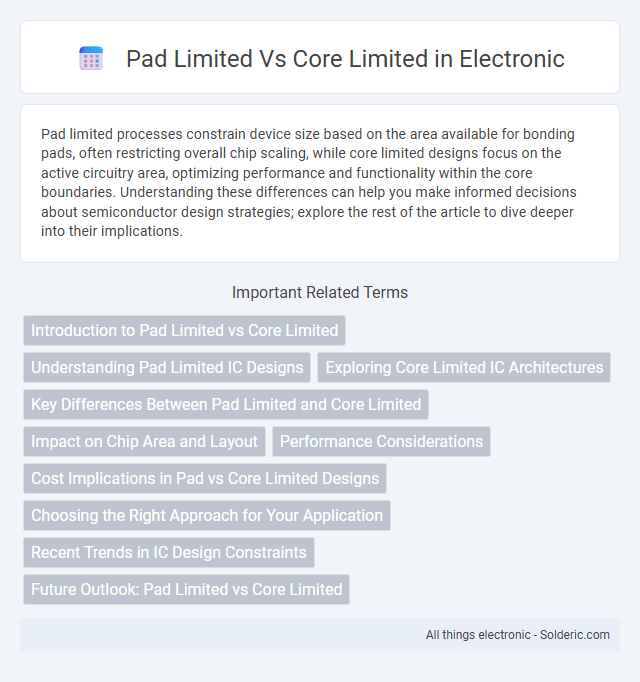Pad limited processes constrain device size based on the area available for bonding pads, often restricting overall chip scaling, while core limited designs focus on the active circuitry area, optimizing performance and functionality within the core boundaries. Understanding these differences can help you make informed decisions about semiconductor design strategies; explore the rest of the article to dive deeper into their implications.
Comparison Table
| Feature | Pad Limited | Core Limited |
|---|---|---|
| Definition | Restriction on the physical interface points (pads) in a chip or device. | Restriction on the core processing units or CPUs available. |
| Focus | Hardware input/output limitations. | Processing power and computational capability. |
| Impact | Limits number of pins and connections. | Restricts the number of processor cores active or accessible. |
| Use Case | Device packaging and physical connectivity design. | Multi-core CPU management, performance scaling. |
| Example | Microcontroller with pad count limited to reduce package size. | Server CPU with some cores disabled for power saving. |
Introduction to Pad Limited vs Core Limited
Pad Limited and Core Limited represent two distinct types of electrical constraints in integrated circuit design, where Pad Limited refers to limitations imposed by the external input/output pads, affecting signal integrity and pin count, while Core Limited pertains to constraints within the chip's internal core area, influencing logic density and power consumption. Understanding the differences between Pad Limited and Core Limited designs is crucial for optimizing chip performance, yield, and manufacturability, especially in advanced semiconductor nodes. Design strategies balancing Pad Limited and Core Limited factors enhance overall device efficiency by addressing both external interface requirements and internal circuit complexities.
Understanding Pad Limited IC Designs
Pad limited IC designs are constrained by the number and placement of input/output pads, which impacts signal integrity and chip area utilization. Core limited designs prioritize the internal circuitry's area and performance, optimizing transistor density and functionality over pad arrangement. Understanding how pad limitations affect your IC layout is crucial for balancing chip size, power consumption, and I/O capabilities.
Exploring Core Limited IC Architectures
Core limited IC architectures emphasize maximizing the number of functional cores within the silicon die, constrained primarily by thermal dissipation and power delivery limits rather than package pin count. These designs leverage advanced transistor scaling and on-chip interconnect optimization to enhance processing density while maintaining efficiency. Unlike pad limited architectures that are restricted by input/output pad counts, core limited ICs prioritize internal core integration to boost computational throughput and parallelism.
Key Differences Between Pad Limited and Core Limited
Pad Limited offers flexible, shareholder-friendly features allowing shareholders to withdraw shares with minimal restrictions, promoting liquidity and responsiveness to market changes. Core Limited imposes stricter limitations on share transfers, ensuring stability and long-term commitment from investors by restricting share exit options. Understanding these differences helps you choose the structure best suited to your investment or corporate governance goals.
Impact on Chip Area and Layout
Pad limited designs constrain chip area primarily by the fixed size and spacing of I/O pads, often leading to underutilized silicon in the core region. Core limited designs maximize core area utilization, pushing density and complexity within the chip's interior, while placing fewer restrictions on the pad ring. Understanding whether your design is pad limited or core limited helps optimize layout strategies to balance chip area efficiency and manufacturability.
Performance Considerations
Pad-limited conditions restrict transistor performance due to the finite size and parasitic capacitance of the input/output pads, causing increased signal delay and power consumption. Core-limited constraints arise when the intrinsic transistor switching speeds and transistor sizing determine the overall circuit speed, often leading to a trade-off between area and performance within the core logic. Optimizing Your design involves balancing pad driver strength and core transistor sizing to achieve optimal signal integrity and minimize latency under both pad-limited and core-limited scenarios.
Cost Implications in Pad vs Core Limited Designs
Pad-limited designs often incur higher manufacturing costs due to the increased area required for testing pads, which can lead to larger chip sizes and reduced yield efficiency. Core-limited designs minimize these expenses by optimizing test structures within the functional core, effectively reducing silicon real estate and associated process costs. Your choice between pad-limited and core-limited approaches significantly impacts overall production budget and scalability in semiconductor fabrication.
Choosing the Right Approach for Your Application
Choosing between pad limited and core limited designs depends on your application's power delivery and area constraints. Pad limited approaches prioritize placing pads to optimize power distribution and minimize voltage drop, ideal for applications demanding robust I/O transient handling. Core limited strategies optimize internal core areas for performance and power efficiency, making them suitable for high-density logic circuits with stringent timing requirements.
Recent Trends in IC Design Constraints
Pad limited and core limited conditions critically influence integrated circuit (IC) design constraints, where pad limited scenarios arise when the number of input/output (I/O) pads restricts chip functionality, while core limited conditions occur due to limited silicon area or transistor density within the core logic. Recent trends show a shift toward advanced packaging and 3D integration techniques to alleviate pad limitations by increasing I/O bandwidth and density. Concurrently, core limited designs benefit from innovations in process node scaling and architectural optimizations that enhance transistor performance and power efficiency under stringent area constraints.
Future Outlook: Pad Limited vs Core Limited
Pad Limited demonstrates robust expansion potential driven by its diversified product portfolio and strategic investments in emerging markets, positioning it favorably for future growth. Core Limited, with its specialized focus on core technologies and innovation, is poised to capitalize on advancements in AI and machine learning, ensuring strong competitive advantages. Market analysts predict Pad Limited will lead in market share growth, while Core Limited is expected to dominate niche sectors requiring specialized technical expertise.
Pad limited vs Core limited Infographic

 solderic.com
solderic.com